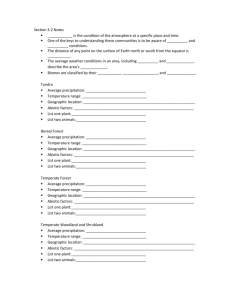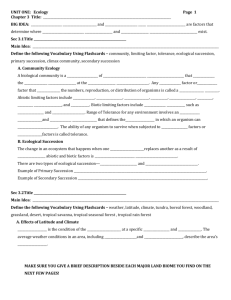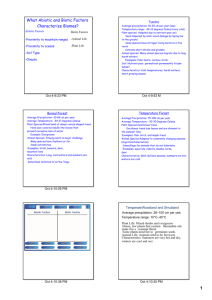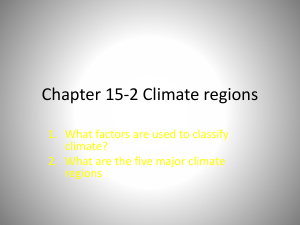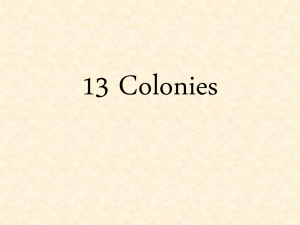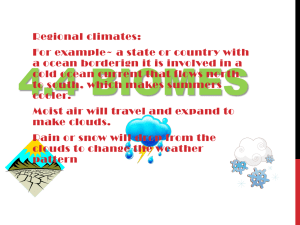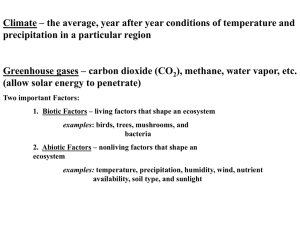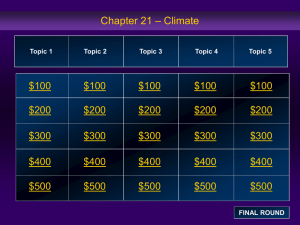ch 3 Jeopardy
advertisement
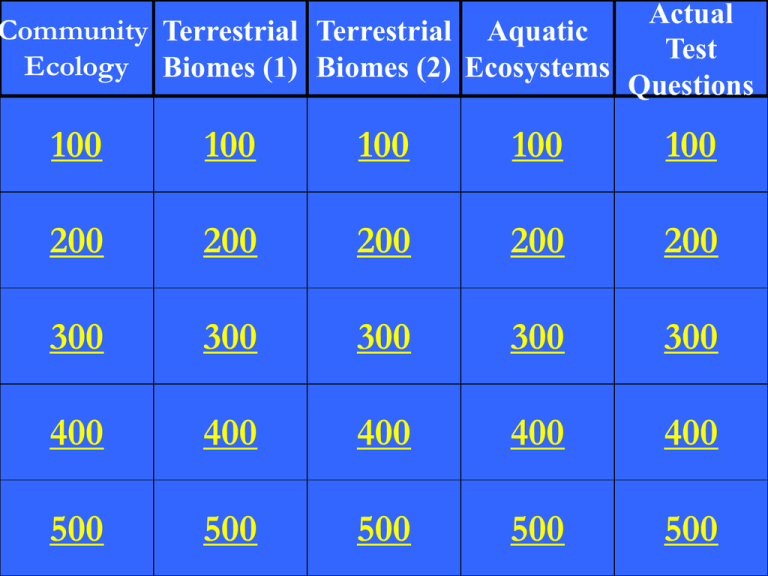
Actual Community Terrestrial Terrestrial Aquatic Test Ecology Biomes (1) Biomes (2) Ecosystems Questions 100 100 100 100 100 200 200 200 200 200 300 300 300 300 300 400 400 400 400 400 500 500 500 500 500 Any abiotic factor or biotic factor that restricts the numbers, reproduction, or distribution of organisms Limiting Factor The orderly and predictable change that takes place after a community of organisms has been removed but the soil has remained intact Secondary Succession The stable, mature community that results when there is little change in the number of species Climax Community The ability of any organism to survive when subjected to abiotic factors or biotic factors Tolerance The establishment of a community in an area of exposed rock that does not have any topsoil Primary Succession The distance of any point on the surface of Earth north or south from the equator Latitude The average weather conditions in an area, including temperature and precipitation Climate Average Precipitation: 25-43 cm/yr; Temperature range: 10oC – 40oC; Geographic location: surrounds the Mediterranean Sea, western coast of North and South America, South Africa, and Australia; Abiotic Factors: summers very hot and dry, winters are cool and wet Temperate Woodland and Shrubland Average Precipitation: 15-26 cm/yr; Temperature range:high o o o o 20 C – 49 C, low: 2 C – 26 C ; Geographic location: every continent except Europe; Abiotic Factors: varying temperatures, low rainfall Desert Average Precipitation: 38-51 o cm/yr; Temperature range: -68 C – 32oC; Geographic location: Northern part of North America, Europe, and Asia; Abiotic Factors: summers are short and moist, winters are long, cold, and dry Boreal Forest Average Precipitation: 75-150 o cm/yr; Temperature range: -30 C – 30oC; Geographic location: South of the boreal forests in eastern North America, eastern Asia, and Europe; Abiotic Factors: well-defined seasons, summers are hot, winters are cold Temperate Forest Average Precipitation: 50-89 o cm/yr; Temperature range: -40 C – 38oC; Geographic location: North America, South America, Asia, Africa, and Australia; Abiotic Factors: summers are hot, winters are cold, moderate rainfall, fires possible Temperate Grassland Average Precipitation: 50-150 cm/yr; Temperature range: 24oC o – 49 C; Geographic location: Africa, South America, and Australia; Abiotic Factors: summers are hot and rainy, winters are cool and dry Tropical Savanna Average Precipitation: 125-660 cm/yr; Temperature range: 20oC – 34oC; Geographic location: Central and South America, southeastern Asia, western Africa, and northeastern Australia; Abiotic Factors: humid all year, hot and wet Tropical Rainforest Average Precipitation: 130-180 cm/yr; Temperature range: 20oC – 25oC; Geographic location: Africa, Asia, Australia, and Central America; Abiotic Factors: rainfall is seasonal Tropical Seasonal Forest The area closest to the shore in a lake with many different types of organisms Littoral Zone The deepest areas of a large lake which is much colder and lower in oxygen than the other two zones Profundal Zone An ecosystem that is formed where a freshwater river or stream merges with the ocean Estuary The area along the ocean floor that consists of sand, silt, and dead organisms Benthic Zone The deepest region of the ocean with very cold water Abyssal Zone A student notices that her guppies reproduce most when her fish tank water is slightly alkaline. They stop reproducing if the water becomes acidic or if the water becomes too alkaline. This is an example of ___ a. secondary succession b. zones of tolerance c. communities d. intertidal zones b. zones of tolerance What single feature is primarily responsible for the variation of climate in different parts of the world? a. intensity of wind b. angle of incoming sunlight c. length of daylight d. amount of precipitation b. angle of incoming sunlight Which of these species would you classify as a profundal zone organism? a. frog b. plankton c. crayfish d. floating water plants c. crayfish Which of these species might be classified as a pioneer species? a. ponderosa pine b. choke cherry c. aspen d. lichen d. lichen In a climax community there is very little change in the number of ________________ Species
